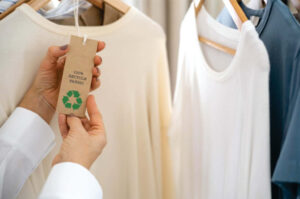Sustainable fashion is gaining momentum, but misconceptions continue to spread. Many brands capitalize on sustainability as a marketing tool, making it challenging to distinguish facts from fiction. Understanding sustainable fashion myths enables consumers to make informed decisions and avoid deceptive greenwashing tactics. Let’s debunk the most common myths and uncover the reality behind them.

Myth #1: Sustainable Fashion is Only for the Wealthy
A widespread sustainable fashion myth suggests that eco-friendly clothing is unaffordable. Many believe that only premium brands prioritize ethical production, making it inaccessible for the average shopper.
Reality: Sustainable Fashion Can Be Accessible
While some ethical brands charge more due to fair wages and sustainable materials, affordable options exist. Second-hand shopping, clothing swaps, and upcycling offer budget-friendly ways to embrace sustainability. Many emerging brands are also offering ethical fashion at competitive prices, making eco-conscious shopping more attainable. Additionally, buying fewer high-quality pieces instead of excessive fast fashion purchases saves money in the long run. Long-lasting clothing also reduces waste, making it both an economic and environmental win.
Myth #2: Every Brand Claiming Sustainability is Truly Eco-Friendly
Some companies market their products as «green» without genuine environmental responsibility. Misleading claims often attract eco-conscious consumers who unknowingly support brands that do not practice true sustainability.
Reality: Greenwashing is a Growing Concern
Greenwashing happens when brands exaggerate or falsely claim sustainability efforts. To verify a brand’s credibility, look for third-party certifications like GOTS (Global Organic Textile Standard), Fair Trade, and OEKO-TEX. Ethical brands openly share details about their production process, labor policies, and material sourcing. A truly sustainable brand will have transparency reports, detailed supply chain disclosures, and verified eco-friendly initiatives. Checking independent sustainability reviews can also help assess whether a brand is genuinely sustainable.
Myth #3: Organic Cotton is the Only Sustainable Fabric
Many assume that organic cotton is the ultimate eco-friendly material. While organic cotton has benefits, it is not the sole solution to making fashion more sustainable.
Reality: There Are Many Eco-Friendly Textiles
Sustainable fashion incorporates materials such as hemp, linen, Tencel, bamboo, and recycled fabrics. These textiles have a lower environmental footprint than conventional cotton and contribute to long-lasting, responsible fashion choices. Some synthetic fabrics, such as those made from recycled plastic, also help repurpose waste and prevent pollution, proving that sustainability is about innovation, not just one material. Exploring fabric alternatives ensures a more diverse and efficient approach to sustainability.
Myth #4: Fast Fashion Brands Can Be Sustainable
Several well-known fast fashion brands launch «conscious collections» and claim they are becoming more sustainable. But can these companies truly be eco-friendly?
Reality: Fast Fashion and Sustainability Are Incompatible
Fast fashion thrives on mass production, low-cost labor, and disposable trends. A single «green» collection does not make a brand sustainable. Genuine change requires companies to overhaul production models, pay fair wages, and prioritize durability over fleeting trends. Sustainability must be a core principle, not just a seasonal campaign. If a company continues to produce excessive quantities of low-quality clothing, its sustainability claims remain questionable. Consumers should investigate whether brands are committed to long-term environmental and social change.

Myth #5: Sustainable Fashion is Dull and Lacks Variety
Some believe that ethical clothing is plain, lacking in colors, patterns, and creative designs, making it unappealing for trend-conscious shoppers.
Reality: Sustainable Fashion is Stylish and Innovative
Many sustainable brands produce trendy, unique collections. Ethical designers incorporate recycled fabrics, natural dyes, and artisanal craftsmanship to create high-quality fashion. Thrift shopping and upcycling also allow individuals to express their style in original ways. Some sustainable brands even collaborate with renowned designers, ensuring eco-friendly clothing remains fashionable and desirable. Sustainable fashion is no longer limited to basics—many eco-conscious collections rival mainstream fashion trends in creativity and appeal.
Myth #6: Individual Shopping Choices Don’t Influence the Industry
Some believe that an individual’s shopping choices have little influence on the fashion industry. They assume that large corporations hold the real power in sustainability efforts.
Reality: Consumers Shape the Future of Fashion
Supporting ethical brands, reducing consumption, and opting for second-hand shopping all contribute to a larger movement. As demand for sustainability grows, more brands adapt their practices. According to Good On You, consumer awareness drives industry shifts towards responsible production. The power of collective action cannot be underestimated—small individual changes influence market trends and push corporations toward greener solutions. Over time, increased demand for ethical products forces brands to change their production strategies.
Myth #7: Recycling Clothes Solves the Fashion Waste Crisis
Many believe that donating or recycling old clothing is the perfect solution to fashion waste and that their old clothes will always find a new home.
Reality: Most Recycled Clothes Still End Up in Landfills
Recycling helps, but the sheer volume of textile waste exceeds repurposing capabilities. Many donated clothes are exported to other countries, where they often go unused. Some textiles are downcycled into industrial rags or insulation, but most end up in landfills. The best approach is to buy fewer but higher-quality garments and extend their lifespan through proper care, repairs, and creative reuse. Learning to mend or alter clothing can significantly reduce the need for new purchases. Consumers should also consider supporting brands that implement take-back programs for responsible recycling.
Myth #8: Sustainable Fashion is Only About the Environment
Sustainability is often associated with reducing pollution, but ethical fashion encompasses more than environmental concerns.
Reality: Fair Labor and Ethical Practices Are Equally Important
Sustainable fashion promotes fair wages, safe workplaces, and respect for labor rights. Ethical brands balance environmental responsibility with social impact. They ensure that garment workers receive fair pay and humane treatment. Many major fashion companies outsource labor to countries with poor working conditions. Sustainability efforts must include protecting workers as much as the planet. Choosing brands that value fair labor practices supports both ethical production and long-term sustainability.

How to Recognize Truly Sustainable Fashion Brands
With so many sustainable fashion myths, it’s essential to differentiate real ethical brands from misleading ones. Here’s how:
1. Look for Certified Sustainable Labels
Recognized certifications such as GOTS, Fair Trade, OEKO-TEX, and B Corp indicate ethical sourcing and responsible manufacturing. These labels guarantee that strict environmental and social standards are met.
2. Investigate a Brand’s Transparency
Authentic sustainable brands disclose information about materials, labor conditions, and production methods. If a company lacks transparency, it may be engaging in greenwashing. Ethical brands often publish sustainability reports, showing measurable progress and long-term goals. Examining these reports provides insight into whether a company is making real changes or simply marketing sustainability.
3. Embrace Slow Fashion and Pre-Loved Clothing
Purchasing second-hand garments, supporting slow fashion brands, and repairing existing clothing significantly reduce waste. Vintage shopping, clothing swaps, and DIY alterations are excellent sustainable alternatives. Slow fashion encourages mindful purchasing and discourages impulse buying, leading to long-term wardrobe sustainability.
4. Choose Timeless, High-Quality Pieces
Building a wardrobe with versatile, well-made clothing minimizes overconsumption. Investing in durable fashion helps reduce waste and promotes long-term sustainability. Instead of chasing fast fashion trends, curating a wardrobe with timeless, mix-and-match pieces ensures lasting style and minimizes unnecessary purchases.
Understanding sustainable fashion myths helps consumers make mindful shopping decisions. Supporting ethical brands ensures a commitment to true sustainability. Choosing durable clothing, reducing fast fashion purchases, and investing in timeless pieces create a more eco-conscious industry. Each conscious choice contributes to a shift toward responsible production. Informed consumers help shape a fashion industry that respects both the planet and the workers behind every garment.
Vintage and Second-Hand: Why It’s Trendy and Eco-Friendly
Dressing for Your Body Type: Flattering Outfits for Every Shape

I’m Victoria, the creator behind Eva My Balance. Passionate about beauty, wellness, sustainable living, and mindful self-care. My mission is to inspire you to live consciously and beautifully—inside and out.


